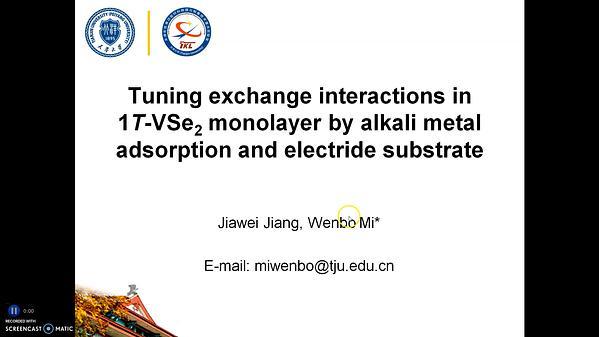Would you like to see your presentation here, made available to a global audience of researchers?
Add your own presentation or have us affordably record your next conference.
Chromium-rich Cr-V alloys exhibit three phases: Paramagnetic phase (P) above Néel temperature (TN), a transverse polarization spin-density-wave (SDW) phase (AF1) below TN and above the spin-flip temperature (TSF), and a longitudinal polarization SDW phase (AF2) below TSF. Varying the electron/atom ratio in the Cr alloy, one can go from incommensurate to commensurate SDW and modifies different physical properties 1.
In the paramagnetic phase, Cr exhibit a Pauli susceptibility with slight temperature dependence1. Otherwise, the introduction of small amounts of V in Cr not only changes TN, but also induced a Curie-Weiss behavior (CW) that we have associated to local magnetic moments. This behavior is limited up to 0.7%V and magnetic fields of 15 kOe 2. This behavior was also observed for different Cr alloys 3-5. The origin of local magnetic moments has been associated with the establishment of local spin-density waves (LSDW) around V impurities 2,6.
In this work, we presented an investigation of the effects of local magnetic moments in antiferromagnetic phases in Cr-V alloys. The samples are single crystals with a concentration up to 0.7% V. Magnetization measurements as a function of temperature were performed using a VSM SQUID magnetometer MPMS3 by Quantum Design using zero field cooling (ZFC) and field cooling (FC) protocols. Figure 1 presents the magnetic susceptibility (χDC(T)) as a function of temperature under a magnetic field H = 100 Oe (a) and 10 kOe (b) for single crystal of Cr-0.4 at.%V. The ZFC measurement shown in Fig 1(a) shows a jump as TN is approached followed by a C-W behavior up to 400 K. However, below TN χDC (T) the FC measurement exhibit a strong anisotropy, likely associated with local magnetic moments frozen in the cooling process, from the paramagnetic phase. Fig 1(b) shows that 10 kOe suppresses the CW effect above TN, in the AF1 phase χDC is identical for both processes ZFC and FC and in the AF2 phase χDC becomes larger for ZFC as compared to FC. These results show that local moments around V impurities depend on magnetic history.
